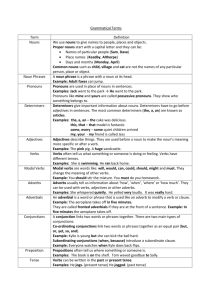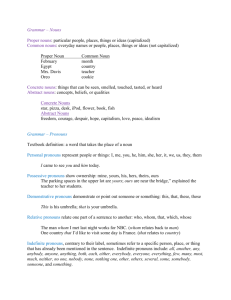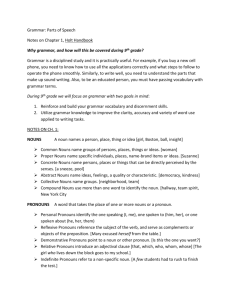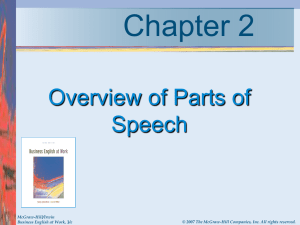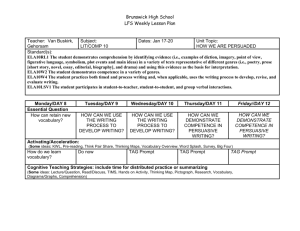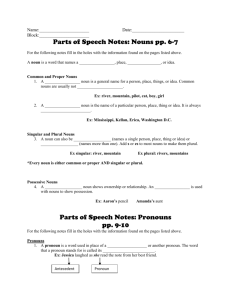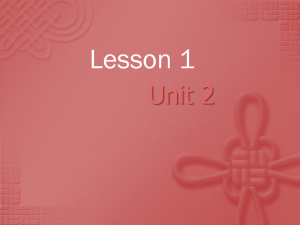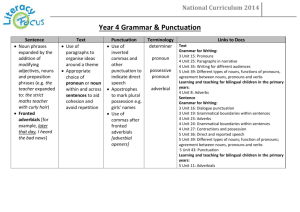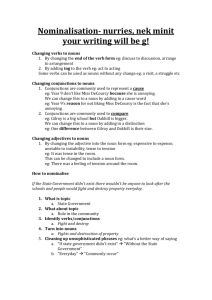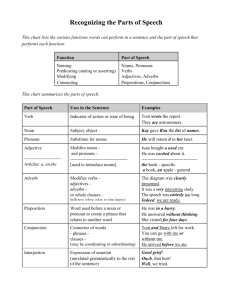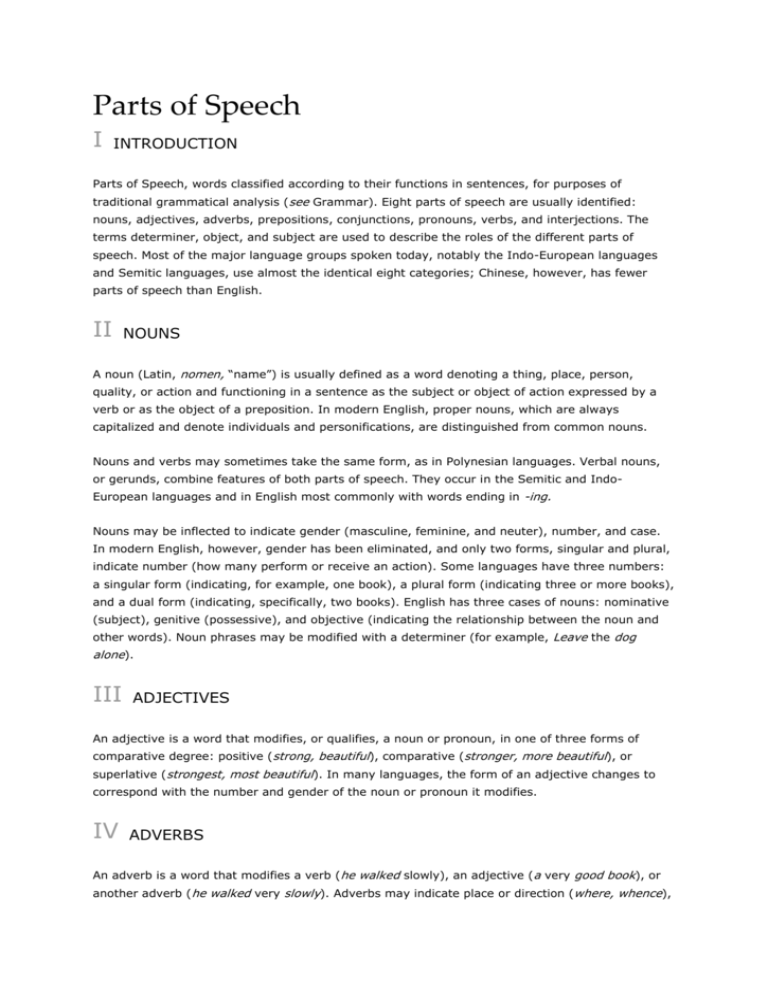
Parts of Speech
I
INTRODUCTION
Parts of Speech, words classified according to their functions in sentences, for purposes of
traditional grammatical analysis (see Grammar). Eight parts of speech are usually identified:
nouns, adjectives, adverbs, prepositions, conjunctions, pronouns, verbs, and interjections. The
terms determiner, object, and subject are used to describe the roles of the different parts of
speech. Most of the major language groups spoken today, notably the Indo-European languages
and Semitic languages, use almost the identical eight categories; Chinese, however, has fewer
parts of speech than English.
II
NOUNS
A noun (Latin, nomen, “name”) is usually defined as a word denoting a thing, place, person,
quality, or action and functioning in a sentence as the subject or object of action expressed by a
verb or as the object of a preposition. In modern English, proper nouns, which are always
capitalized and denote individuals and personifications, are distinguished from common nouns.
Nouns and verbs may sometimes take the same form, as in Polynesian languages. Verbal nouns,
or gerunds, combine features of both parts of speech. They occur in the Semitic and IndoEuropean languages and in English most commonly with words ending in -ing.
Nouns may be inflected to indicate gender (masculine, feminine, and neuter), number, and case.
In modern English, however, gender has been eliminated, and only two forms, singular and plural,
indicate number (how many perform or receive an action). Some languages have three numbers:
a singular form (indicating, for example, one book), a plural form (indicating three or more books),
and a dual form (indicating, specifically, two books). English has three cases of nouns: nominative
(subject), genitive (possessive), and objective (indicating the relationship between the noun and
other words). Noun phrases may be modified with a determiner (for example, Leave the dog
alone).
III
ADJECTIVES
An adjective is a word that modifies, or qualifies, a noun or pronoun, in one of three forms of
comparative degree: positive (strong, beautiful), comparative (stronger, more beautiful), or
superlative (strongest, most beautiful). In many languages, the form of an adjective changes to
correspond with the number and gender of the noun or pronoun it modifies.
IV
ADVERBS
An adverb is a word that modifies a verb (he walked slowly), an adjective (a very good book), or
another adverb (he walked very slowly). Adverbs may indicate place or direction (where, whence),
time (ever, immediately), degree (very, almost), manner (thus, and words ending in -ly, such as
wisely), and belief or doubt (perhaps, no). Like adjectives, they too may be comparative (wisely,
more wisely, most wisely).
V
PREPOSITIONS
Words that combine with a noun or pronoun to form a phrase are termed prepositions. In
languages such as Latin or German, they change the form of the noun or pronoun to the objective
case (as in the equivalent of the English phrase give to me), or to the possessive case (as in the
phrase the roof of the house).
VI
CONJUNCTIONS
Conjunctions are the words that connect sentences, clauses, phrases, or words, and sometimes
paragraphs. Coordinate conjunctions (and, but, or, however, nevertheless, neither... nor) join
independent clauses, or parts of a sentence; subordinate conjunctions introduce subordinate
clauses (where, when, after, while, because, if, unless, since, whether).
VII
PRONOUNS
A pronoun is an identifying word used instead of a noun and inflected in the same way nouns are.
In English, personal pronouns are I, you, he/she/it, we, you (plural), and they. Demonstrative
pronouns are thus, that, and such. Introducing questions, who and which are interrogative
pronouns; when introducing clauses they are called relative pronouns. Indefinite pronouns are
each, either, some, any, many, few, and all.
VIII
VERBS
Words that express some form of action are called verbs. Their inflection, known as conjugation, is
simpler in English than in most other languages. Conjugation in general involves changes of form
according to person and number (who and how many performed the action), tense (when the
action was performed), voice (indicating whether the subject of the verb performed or received the
action), and mood (indicating the frame of mind of the performer). In English grammar, verbs
have three moods: the indicative, which expresses actuality; the subjunctive, which expresses
contingency; and the imperative, which expresses command (I walk; I might walk; Walk!)
Certain words, derived from verbs but not functioning as such, are called verbals. In addition to
verbal nouns, or gerunds, participles can serve as adjectives (the written word), and infinitives
often serve as nouns (to err is human).
IX
INTERJECTIONS
Interjections are exclamations such as oh, alas, ugh, or well (often printed with an exclamation
mark). Used for emphasis or to express an emotional reaction, they do not truly function as
grammatical elements of a sentence.
Microsoft ® Encarta ® 2006. © 1993-2005 Microsoft Corporation. All rights reserved.


